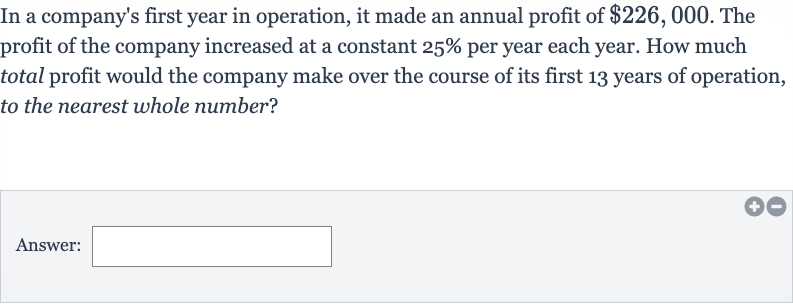AI tutor
Welcome to Bytelearn!
Let’s check out your problem:

In a company's first year in operation, it made an annual profit of . The profit of the company increased at a constant per year each year. How much total profit would the company make over the course of its first years of operation, to the nearest whole number?Answer:
Full solution
Q. In a company's first year in operation, it made an annual profit of . The profit of the company increased at a constant per year each year. How much total profit would the company make over the course of its first years of operation, to the nearest whole number?Answer:
- Identify initial profit and rate: Identify the initial profit and the rate of increase.The initial profit is , and the profit increases by each year.
- Determine formula for total profit: Determine the formula to calculate the total profit over years.The profit follows a geometric sequence where each term is times the previous term (since the profit increases by each year).The formula for the sum of a geometric series is , where:- is the sum of the first terms,- is the first term,- is the common ratio,- is the number of terms.Here, r = .n = $.
- Calculate total profit formula: Calculate the total profit using the geometric series sum formula.\(\newline\)\(S_{13} = \frac{226,000(1 - 1.25^{13})}{(1 - 1.25)}\)
- Perform necessary calculations: Perform the calculations.\(\newline\)First, calculate \(1.25^{13}\):\(\newline\)\(1.25^{13} \approx 18.14\) (rounded to two decimal places for simplicity)\(\newline\)Then, substitute this value into the formula:\(\newline\)\(S_{13} = 226,000(1 - 18.14) / (1 - 1.25)\)\(\newline\)\(S_{13} = 226,000(-17.14) / (-0.25)\)
- Continue calculation: Continue the calculation.\(\newline\)\(S_{13} = 226,000 \times 17.14 / 0.25\)\(\newline\)\(S_{13} = 3,874,040 / 0.25\)\(\newline\)\(S_{13} = 15,496,160\)
- Round total profit: Round the total profit to the nearest whole number.\(\newline\)The total profit to the nearest whole number is \(\$15,496,160\).
More problems from Exponential growth and decay: word problems
QuestionGet tutor help
QuestionGet tutor help
QuestionGet tutor help
QuestionGet tutor help
QuestionGet tutor help
QuestionGet tutor help
QuestionGet tutor help
QuestionGet tutor help
QuestionGet tutor help
